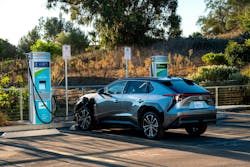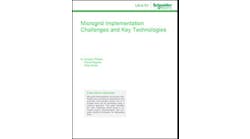Bidirectional Charging Gains Ground with Toyota Project and Federal, California Bills
Bidirectional charging, which holds the promise of converting electric vehicles (EV) into mobile microgrids that can serve as backup resources, income-generating opportunities and grid assets, is seen as critical to the clean energy transition.
Now, with a new federal bill that would mandate EV bidirectional capability by 2027, a California bill that calls for EVs to be bidirectional by 2030 and a partnership between Toyota and San Diego Gas & Electric (SDG&E) to study the charging technology, the promise is moving closer to reality.
In addition, Pacific Gas & Electric (PG&E) announced that the Ford F-150 Lightning 2022 and 2023 models, along with Ford Charge Station Pro and SunRun's Home Integration System, are now eligible for PG&E's residential vehicle to everything (V2X) pilot across northern and central California. PG&E and Ford will study how EVs can provide backup power to customers, help integrate more renewable energy, reduce power usage and allow customers to earn incentives for sending electricity to the grid during periods of high demand.
With bidirectional chargers, homeowners and businesses can take advantage of vehicle-to-everything opportunities, using their EVs as mobile microgrids to charge their homes or buildings when the grid is down. Utilities can utilize EV batteries as stationary storage that helps relieve grid stress, provide grid services and lower carbon emissions. In addition, the chargers can provide environmental equity, replacing polluting gas-fired peaker plants owned by utilities and often located in low-income communities.
Vehicle-to-grid integration ‘more important than any other DER’
“I've been working in clean DER [distributed energy resources] my entire 30-plus years career; vehicle-to-grid integration is an order of magnitude bigger and more important than any other DER resource,” said Kurt Johnson, community energy resilience director at The Climate Center.
Outside of legislation, more opportunities are arising that allow EV owners to participate in programs that sell battery capacity into the market, allowing them to earn income and help defray the initial cost of the EVs.
“We deployed about three dozen bidirectional chargers across the country with Nissan Leaf EVs and made thousands of dollars,” said David Slutzky, founder and chairman of the board of Fermata Energy, a software provider for EV charging platforms. “Now original equipment manufacturers are scrambling to do this and, all of a sudden, EVs are a grid asset.” Fermata Energy has a vehicle-to-everything bidirectional charging platform that allows fleet owners to earn money from their local utilities by using EVs as resources that increase resilience or become a virtual power plant.
For example, Eversource pays EV fleet and car owners who have bidirectional chargers to send energy to the grid when electricity demand is high, Slutzky said.
“Our goal is to understand the ideal customer experience for residential vehicle-to-grid," said Max Parness, senior manager, grid services, Toyota EV Charging Solutions. "Utilities will play a key role in shaping that experience, and so we seek to work closely with key leading utilities to ensure that the experience is meeting customer needs.”
U.S. representative introduces bidirectional charging bill
Congress members are catching on to the benefits of bidirectional charging. On Nov. 3, U.S. Rep. Julia Brownley introduced HB 6178, the Bidirectional EV Charging Act, which would mandate bidirectional capability in EVs by 2027, except when exempted by the U.S. Secretary of Energy. The bill directs the U.S. Department of Energy to create a National Electric Vehicle Bidirectional Charging road map and establish technical standards for EV manufacturers to standardize bidirectional charging technology.
California’s bidirectional charging mandate is still alive
In addition, California’s SB 233 – which calls for EVs to be equipped with bidirectional charging by 2030 – is still in play and will be back in the legislature in 2024, said Johnson. It was amended in the Assembly Appropriations Committee to remove the mandate so rather than bringing it to the assembly floor as amended, Sen. Nancy Skinner made it a two-year bill.
When introduced, SB 233 was “the most important bill of the year in California,” said Peter Asmus, executive director of the Alaska Microgrid Group.
Toyota and SDG&E study bidirectional charging
Now, Toyota Motor North America is wading into the bidirectional charging world. On Nov. 14, the company announced that it’s collaborating with SDG&E on vehicle-to-grid (V2G) research using a Toyota bZ4X, along with Fermata Energy’s bidirectional charger and vehicle-to-grid platform. The aim is to study the needs of EV owners and their charging habits.
SDG&E isn’t the only utility with its sights on EV charging.
Pacific Gas & Electric (PG&E) is working with BMW, Ford and General Motors to test bidirectional charging technologies that will allow EVs to help offset some of the load growth associated with electrification. PG&E has said that the EVs being charged on its grid today represent 6 GW of battery storage capacity – three times what it can generate at the Diablo Canyon Power Plant, a nuclear power plant in San Luis Obispo County, California.
Removing regulatory obstacles to vehicle-to-everything
In addition to such research programs and legislative efforts, bidirectional charging would get a boost from changing regulations and programs that stand in the way of implementing the technology, said Fermata Energy’s Slutzky.
“Don’t impose mandates on original equipment manufacturers,” he said. “Regulate the removal of obstacles.”
For example, California’s Self-Generation Incentive Program provides incentives for stationary storage but not for batteries in EVs, he said. Those incentives should be extended to EV batteries.
“There’s a lot of CapEx in stationary storage. But if storage comes as a vehicle, when it’s parked, it’s free storage,” he said.
Some argue that it’s hard to predict which days and times EV batteries will be available to help out the grid, he said. “If you have enough vehicles on a grid circuit managed by a V2G service provider, software can manage this and present it as a whole as aggregation.”
Bidding EV battery power into PJM markets
In 2015, Fermata Energy used four Nissan Leaf EVs, along with bidirectional chargers, to bid into the frequency regulation market in PJM and “made money,” said Slutzky.
While the Ford F-150 Lightning is best known for bidirectional charging, Nissan Leaf EVs are also capable of bidirectional charging. Tesla – which has resisted the movement – recently said it will offer the capability in 2025.
A number of companies are moving toward releasing bidirectional chargers, including Dcbel and Wallbox.
Increasing EV sales with income opportunities
Once bidirectional chargers are available, they’re expected to increase EV sales. They’ll allow drivers to use their EVs as backup resources during outages and earn income by helping out the grid.
“I predict that in early 2024 we will have options for residential bidirectional charging, and we’ll get people hooked up and they’ll start making money,” said Slutzky.








